Saturday 29th August 2020

Readers may recall my ride on route 404 earlier this month highlighting TfL’s penchant for circuitous bus routes wandering around the back streets of London’s suburbs making sure everyone lives within 400 metres of a bus stop.
But up in Barnet, it’s all change for circuitous route 384. From today it’s had the hair straighteners and extension treatment and almost all its curly bits have been removed. It now runs pretty much direct between Cockfosters and Barnet as well as gaining a significant route extension on to Edgware.

Overnight, the 384 has gone from a Barnet back street wanderer to a North London orbital titan.
Introduced in 1990, the 384 brought a bus route to many previously unserved residential roads between Cockfosters and Barnet. More twiddles were added over the years as well as an extension in Barnet to terminate at Quinta Drive in place of another similar twiddly route.
London’s northernmost bus garage at Potters Bar has been home to the route since its inception (originally operated by the former London Northern company, which sold to MTL in 1994, then sold again to Metroline in 1998) and until yesterday six buses were deployed providing a twenty minute frequency.
So what’s with the change from today? TfL carried out one of its regular reviews of the bus network serving Barnet back in 2017. They found “route 384 is very circuitous serving many local side roads” which shouldn’t have come as too much of a surprise as that’s been the route’s raison d’être for the past 30 years.
The review continued “the route is not well used, especially where it is most circuitous and parked cars restrict the availability of bus stops. The frequency of the route was reduced from 4 buses per hour to 3 buses per hour in recent years but usage figures still do not justify the frequency of the service”.
Another key finding of the review was “no TfL bus route runs directly between Barnet Town Centre/Barnet Hospital and Mill Hill/Edgware”. Route 107 does provide a link from Barnet to Edgware (and has done since 1954) but runs via Borehamwood and Elstree taking about 40 minutes for what could be a journey of not much more than 15 minutes direct via Mill Hill.

I noted the specific words “no TfL bus route runs directly between Barnet…”. There is a direct route but it’s a commercial venture run by the Hatfield based unō bus company, so not regarded as a proper route by TfL.
Unō’s Comet branded route 614 provides an hourly service starting at Queensbury (which by a quirk of coincidence was where the 107 also used to start before being cut back to Edgware in 1993) and runs via Burnt Oak, Edgware, Apex Corner and Stirling Corner then direct to Barnet via Arkley before continuing on to Hatfield. Other than a slightly different routing in Edgware and a twiddly bit via Barnet’s Quinta Drive the newly extended 384 duplicates the 614.

In fact the 384 now follows the same roads served by route 292 from Stirling Corner to Edgware and that’s why TfL has reduced the 292’s frequency from 4 buses per hour to 3 buses per hour, now the 384 is also on the scene. This has reduced the frequency for passengers travelling on the 292 north of Stirling Corner to and from Borehamwood but TfL don’t mind that as that section of route is ‘over the border’ in Hertfordshire so that’s that Council’s problem, not TfL’s.
What should concern TfL is the coordination of timetables between the 292 and 384 now that both run at a 3 bus per hour frequency. How sensible it would be to ensure departures were as evenly spaced as possible to create a 10 minute frequency between Stirling Corner and Edgware. Sadly it was not to be as daytime journeys are timetabled within 2 minutes of each other in one direction (then an 18 minute gap) and 3 minutes apart (followed by 17 minutes) in the other. Not very integrated.
Back to the other end of route 384 and those withdrawn twiddly bits between Cockfosters and New Barnet. TfL consulted on the proposed route straightening and withdrawal from most of the side roads currently served – all except the loop around Westbrook Crescent marked in blue on the map below which continues – between September and November 2018.
Yes, I know that’s two years ago, but this is TfL and timescales on route developments take time to mull over in a “world class transport system” such as London’s.


1,378 responses were received with 54% opposed or strongly opposed to the proposals and 32% supporting or strongly supporting them. In its report on the consultation, and the necessary ‘Equality Impact Assessment’ (EqIA) it’s interesting to see how TfL justify implementing the proposals despite the majority of respondents being opposed to them.
Here’s the “Rationale” summarised by TfL:
“Journey times between Cockfosters and New Barnet and between New Barnet and Chipping Barnet are longer than they need to be due to the circuitous routeing of the 384. Making the service more direct between these locations will lead to increased usage. Extending the service to Edgware will create new direct orbital bus links across North London, improving travel options. In particular it will create a new direct link between Edgware and Barnet Hospital.“
It’s fascinating to see TfL justifying the withdrawal of circuitous routes in favour of increased usage generated from more direct bus routes. A logic they’ve used completely the other way round when it also suits their purpose. The 400 metre guideline seems to have conveniently been dropped in this case and TfL admits “a number of passengers will have a longer walk to access the bus network”. In fact the EqIA explains around half the route’s passengers will face a longer walk – in some cases 600 metres or more – and gives details of where these people live and currently use the bus.
On the other hand “50% of people who currently travel on the 384 will still be able to board or alight at exactly the same place as they currently do. Some of their journeys will be quicker”.
I took a ride out on the 384 earlier this month to see what the withdrawal will mean in practice.
Many of the buses I saw had very few passengers travelling, so I can see “usuage figures still do not justify the frequency of the service” although it didn’t seem much different from many other back street routes in London’s suburbs.
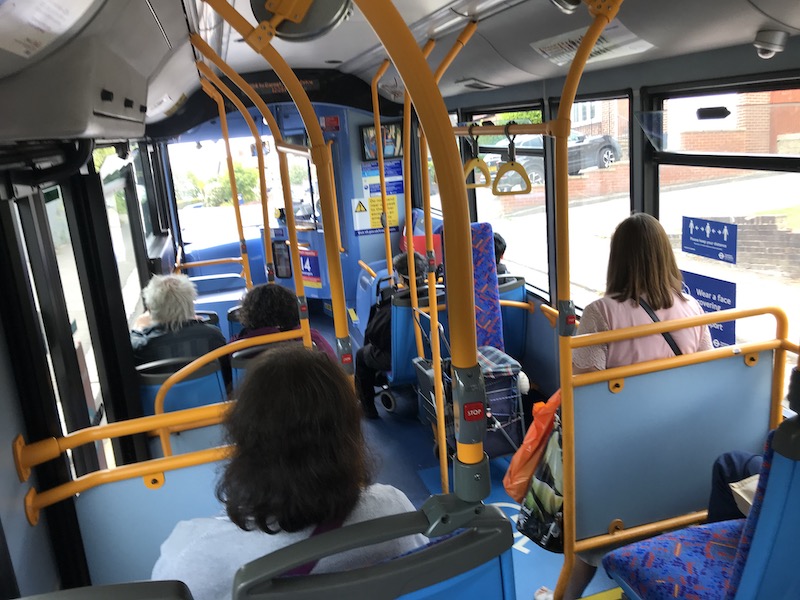
One capacity constrained bus (14 only allowed on board) had a fair load for these Covid times as we left New Barnet station heading towards Barnet (see above) and a few of those on board got off in the Lyonsdown Road and Gloucester Road area which from today is no longer served.

I also alighted here and walked back to New Barnet station. Being fit and active, it didn’t take me long, and personally if I was catching a train I’d be happier walking anyway rather than wait for a twenty minute frequency bus. It’s quite a pleasant walk too with some very mature trees to appreciate along the way.
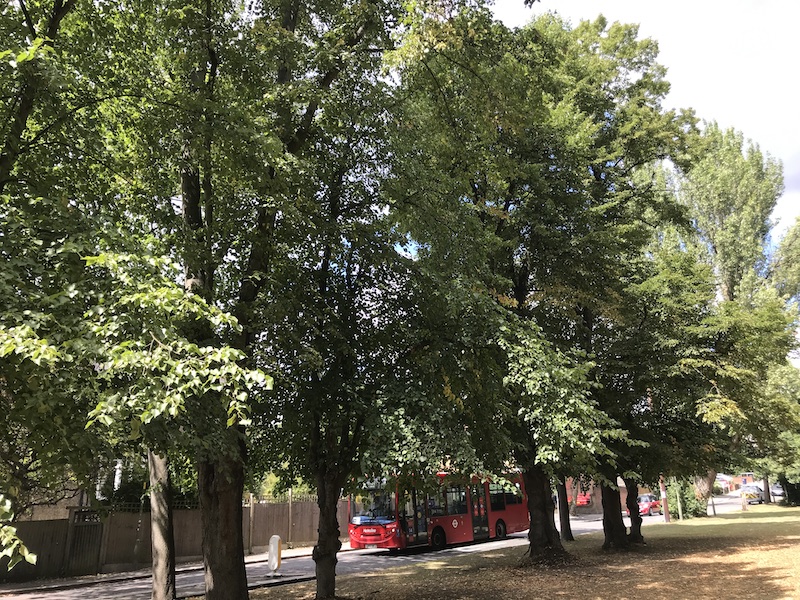
But if I was less agile or returning laden with shopping from the local shops in New Barnet, it would be a completely different matter. I’d very much welcome a bus ride home and which is no longer possible.
I then wandered over to the large section of route around Castlewood Road and Northfield Road which has also become bus-less from today and, partly because it was during the very hot spell of weather, found the walk enjoyable. But again, it would be a different matter on a wet or cold day, and Northfield Road, in particular, has a long steady incline which is quite tiring to walk up. I wouldn’t like to do it if I was less agile. You’re a considerable distance from where the 384 now stops.

On the other hand, I’ve travelled from Cockfosters to Barnet on this route in the past and have to agree it is very circuitous and you do wonder if you’re ever going to reach Barnet especially when the bus turns into Crescent Road and is almost pointing back in the direction you’ve just come from only to then hit East Barnet Road and head back on track again.


There could well be a case for a more direct orbital bus route between Cockfosters, Barnet and Edgware but I wonder if TfL embraced the 614 a bit more and promoted it as part of its network (albiet Oyster is not valid, but contactless is) then that may satisfy the demand at least between Edgware as far as Barnet.
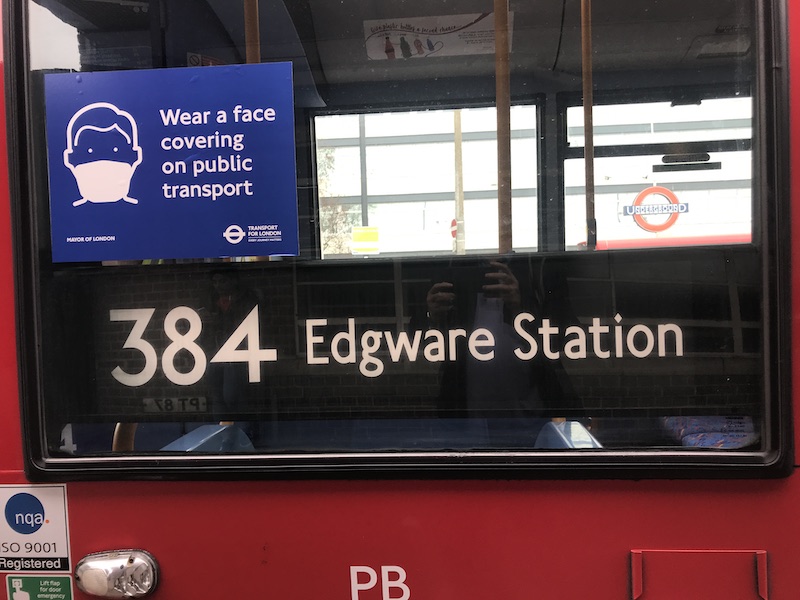
I took a ride on the new look 384 this morning to see how it compares. Whereas the journey between Cockfosters and Barnet Church used to take 27 minutes, the new straightened out route (albeit still including that ride around Westbrook Crescent) now does it in 20 and that was generous as we had to wait time at a number of stops along the way; probably a good five minutes of idling.
After Barnet Church the 384 does a loop to serve The Spires shopping area taking 8 minutes to reach Barnet Hospital whereas routes 263 and 307 which run direct take just 3 minutes. The 384 then diverts around Quinta Drive as it used to do so the effect of all that is a journey time to Edgware from Barnet Church of 33 minutes pretty much double the time taken by unō’s 614 which really is direct.
And I see that as the problem – the 384 has had a bit of straightening out and lost half its passengers but it’s still not providing an attractive journey time to entice a new band of orbital travellers on board. It’s now neither one thing nor the other.
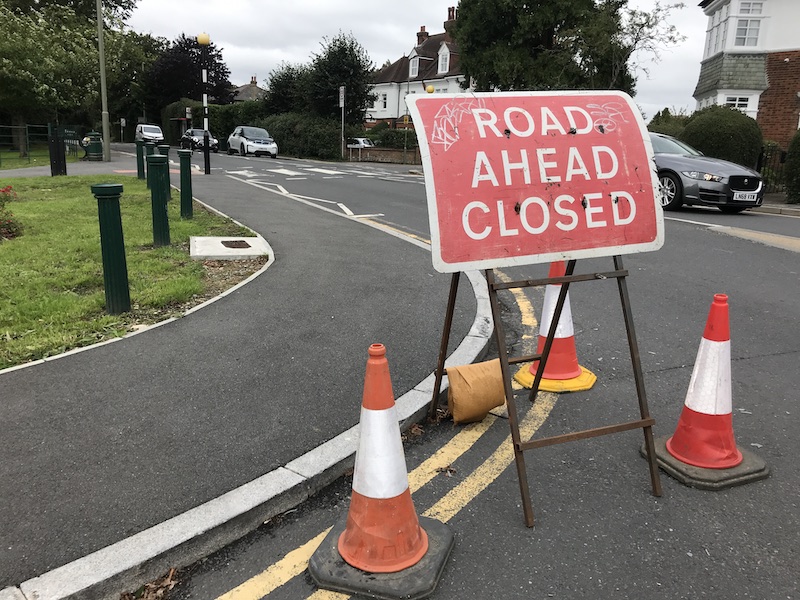
Today was also a chaotic start to the new extension in that the direct route between Barnet and Stirling Corner via Arkley was still closed for the third day due to emergency road works for a burst water main.
This caused added confusion when we arrived in Barnet and dropped off the three passengers we’d gained since Cockfosters before The Spires shops and our driver had to patiently explain to passengers waiting to board there were no buses to Quinta Drive as he was heading off on a long diversion via South Mimms to Edgware where the route had never gone before.
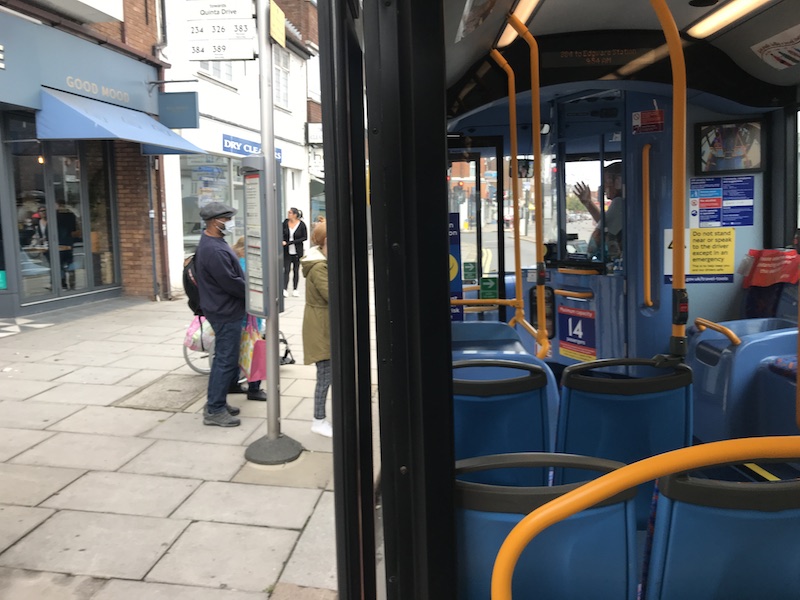
You can forgive passengers for being frustrated and annoyed with a complete lack of information at bus stops not only about the withdrawal of the complete service to their area, but as always with TfL, nothing about the new extension to Edgware either.

There is a ‘status alert’ on TfL’s website if you knew where to click to find it, but there again the website in another place tells you buses are still terminating at Quinta Drive with no reference to the exciting extension to Edgware.

No wonder people are confused.
In the event the diversion up the A1081 and back down the A1 via the M25 junction at South Mimms was quicker than taking the official route via Quinta Drive and Arkley – now there’s a thing – so we spent another five minutes or more losing time at bus stops to be sure we didn’t arrive early into Edgware bus station and Metroline didn’t lose its Quality Incentive Bonus.

I’d noticed TfL’s bus stop flag contractor had been out updating all the tiles by adding 384 where needed (although they missed the one in Station Road)….
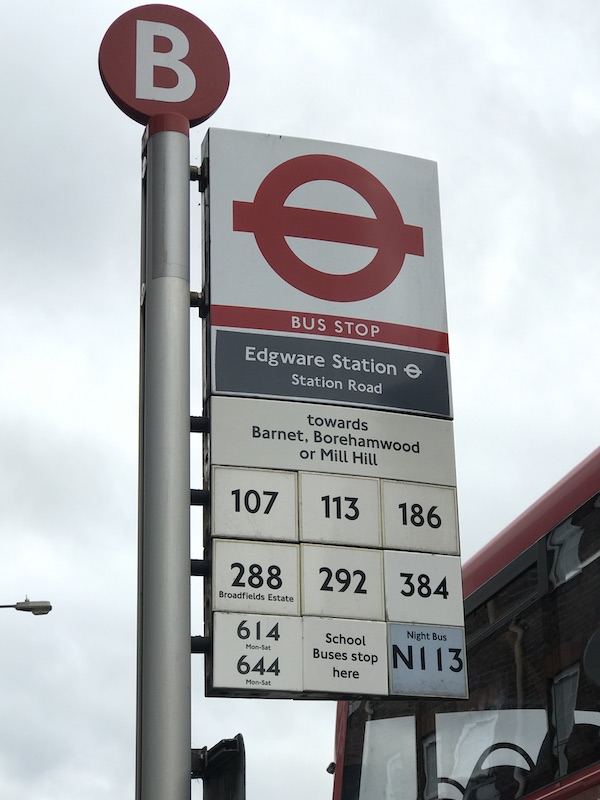
…. but inevitably the timetable case department hadn’t been out …

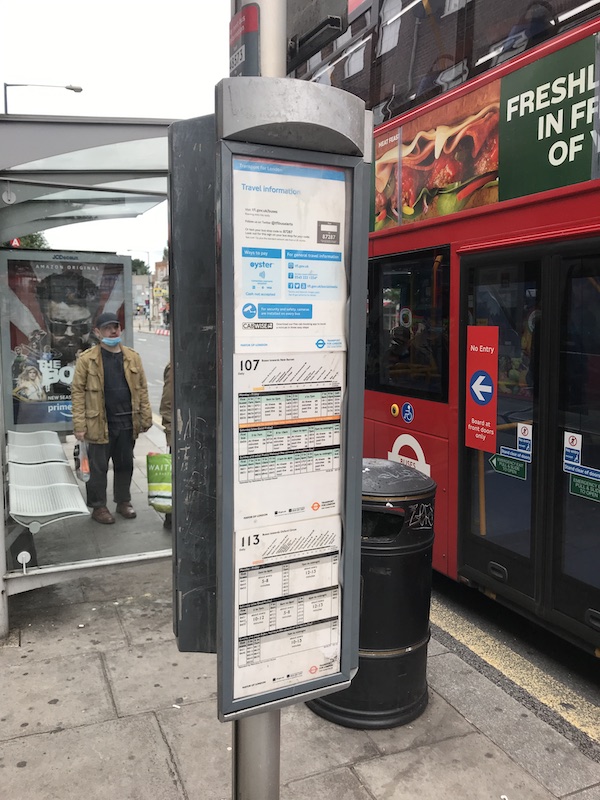
….and there was a complete dearth of bus stop information about the new 384 at newly served bus stops as well as incorrect information at bus stops previously served.

Sadly even more inevitable was no mention of the new service at all at Edgware bus station.

You had to assume it left from stand F as that’s where the 292 departs.
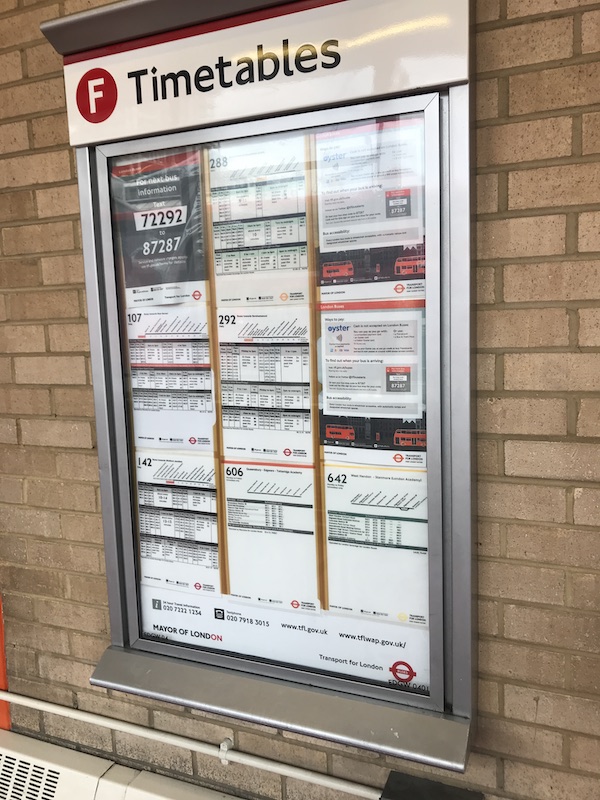

Suffice to say my only companion on my two journeys between Barnet and Edgware was a fellow ‘first day bus rider’. No ‘real’ passengers to be seen. Unless you’re a devoted follower of the intricacies and small print of TfL’s website you’d have no knowledge of this significant route development in north London.
Time will tell if the numbers generated on the new look, partly straightened out, 384 grow to offset those left stranded in the back streets. I have my doubts. Interestingly the three buses TfL have saved from the cut back on the 292 have more than paid for the extra two buses added to the 384 to achieve its extension.
With the 384’s new ‘direct route’ status, it’ll also be interesting to see if the mini style bus stops which have been a familiar feature of the ‘hail and ride’ section of route grow taller and sprout a flag in the Westbrook Crescent area – and show a timetable for both directions too, which is what it should have been doing when I spotted that deficiency earlier this month and was still like it this morning.
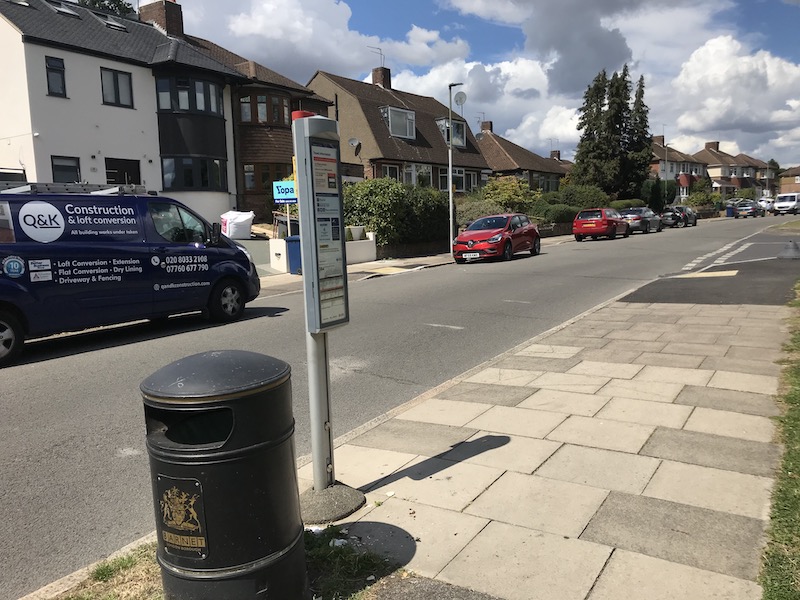

And there’s a shelter going spare in now unserved Castlewood Road.
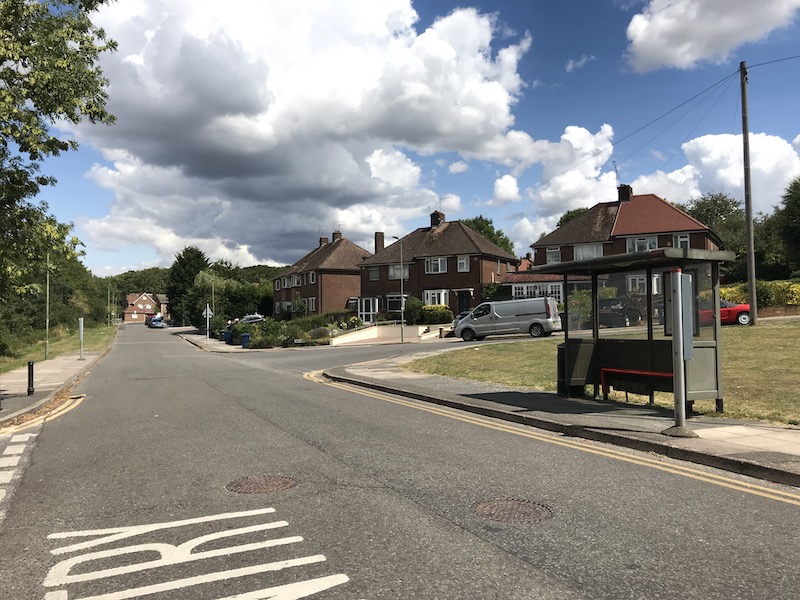
Meanwhile also from today, over in nearby North Finchley, another TfL route extension arrived at that suburb’s infamous Tally Ho terminus – route 112 from Ealing Broadway.

For 35 years between 1935 and 1970 route 112 plied its way along the western arc of the North Circular Road linking Ealing with Palmers Green. A pioneering orbital route from west to north London.
Traffic congestion got the better of it in 1970 and the 112 was cut back from the west to turn at Manor Cottage Tavern, Finchley (with the eastern end to Palmers Green becoming a separate route 212). After junction improvements and widening to the North Circular by 1978 the 112 was re-extended back to Palmers Green again but delays hadn’t gone away and in 1994 it was cut back again this time to Brent Cross shopping centre where it’s terminated until today when North Finchley beckoned as a better place to head for.
As always this extension which sees buses continue along the North Circular via Henlys Corner to Finchley High Road before heading north to North Finchley was consulted on by TfL as the opportunity has also been taken to withdraw the one return journey a day on school bus route 611 which covered the same ground as the newly extended 112. Planners reckoned all the kids could travel on a newly extended scheduled bus on the 112 instead. Mind you, this was before Covid, so possibly the 611 will win a last minute reprieve as I doubt the single decks on the 112 will cope especially as TfL are designating certain journeys for school children only.
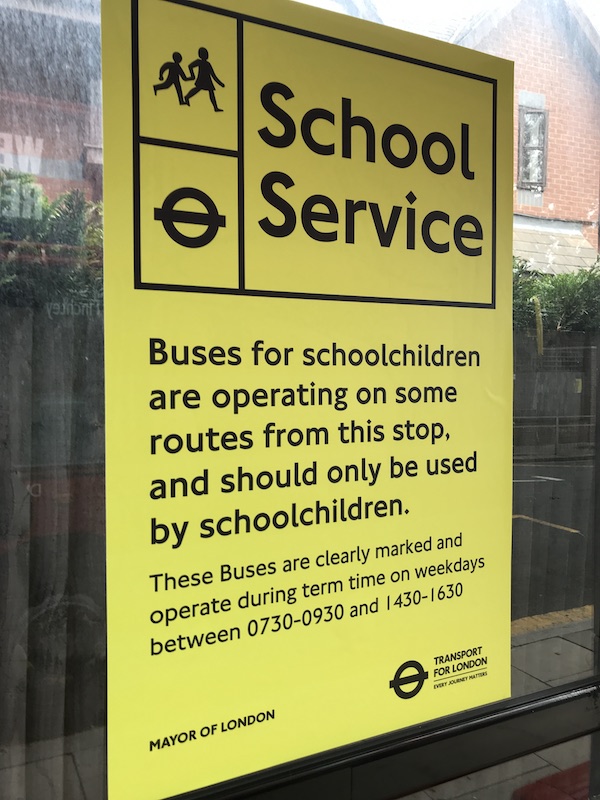
231 responses were received to the consultation in September and October last year with most concerned about the withdrawal of the bespoke 611, not surprising as over half the respondents were travelling to and from school. On route 112 respondents were concerned the extended route would make it less reliable but TfL reckon the recovery time built in at the termini will be enough to counteract that.
It’s very encouraging to read that “over the last ten years there has been substantial growth on bus route 112” with a 50% increase since 2015. “Development plans at Stonebridge Park, Harrow Road and Brent Cross mean passenger numbers are expected to increase further.”
It’s not entirely clear why the 112 is being extended, there’s no evidence of need provided in TfL’s documentation, but it’s a welcome addition to the bus network in north London and provides a new link from North Finchley and Finchley High Road to Brent Cross.
At the other end of route 112 another change from today sees buses take a short cut from the North Circular to its Ealing Broadway terminus by using Madeley Road instead of Uxbridge Road to improve timekeeping as well as giving residents of this road a bus for the first time with new bus stops placed right in the middle.

This proposal has been on the stocks for even longer than the 384, being consulted on back in October and November 2016 – you have to have patience when working in network route planning in TfL. It seems there was quite a bit of work needed on Madeley Road to make it suitable for buses.

The London Borough of Ealing had to resurface the road and install bus stop build outs for the new stops while TfL had to cut back the central island for a ‘buses only’ right hand turn from the North Circular Road into Madeley Road as the junction had previously prohibited right turns in the interests of keeping traffic flowing.

Works of this kind don’t happen overnight so I guess four years is good going.

I arrived in the gloom of North Finchley’s bus station around lunch time today as I made a calculated guess that’s where the 112 would depart from.

Obviously there was absolutely nothing in the bus station to tell me that’s where it departs….

…. not even a service update added to the white board to let us know about this fantastic new route opportunity….

….. and TfL’s online information denied all knowledge of the extension still advising Brent Cross was the limit.
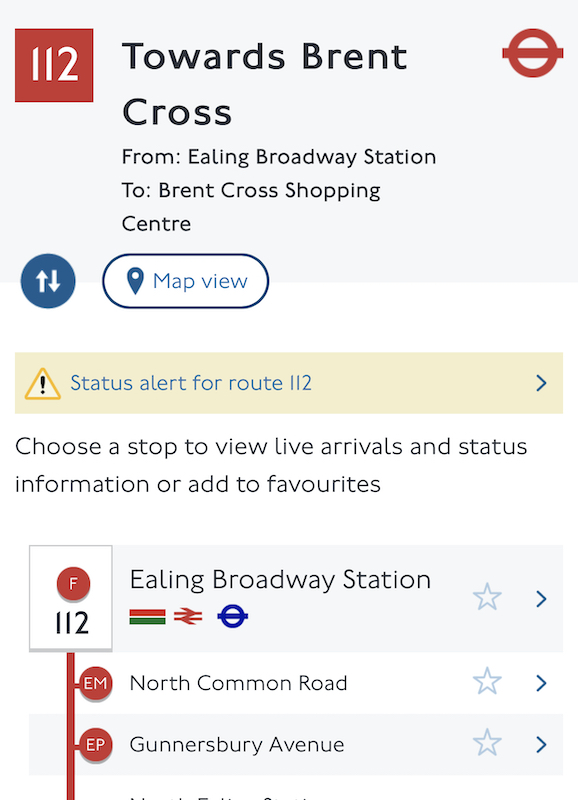
Incredibly two passengers boarded with me seemingly aware of this new link to Brent Cross where they were heading. That really surprised me; they must have been bus enthusiasts disguised as shoppers.

We had a free flowing journey down Finchley High Road before turning right on to the North Circular and it wasn’t long before the brake lights ahead told us we were approaching slow moving traffic towards Henleys Corner which Google confirmed.
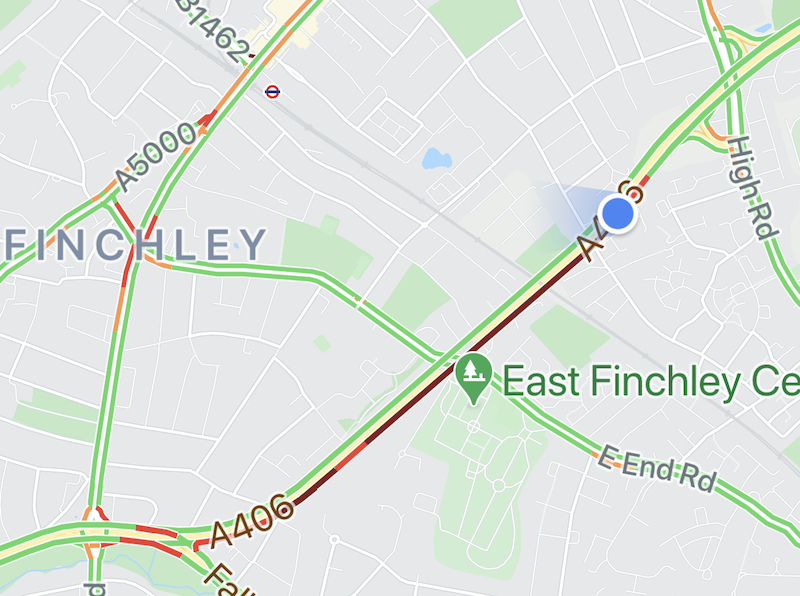
It seems timetable planners guessed there’d be delays as despite the slow progress we arrived at Henleys Corner on schedule and our driver enticed two waiting passengers for Brent Cross on board rather than wait for their more normal 232.

If they’d looked at the bus stop flag they’d have noticed 112 had been added, but obviously nothing in the timetable case would have helped.
We made a driver changeover at the bus stop just before Brent Cross bus station which is a frustrating way of adding three minutes to the journey just as you’re within sight of your destination.
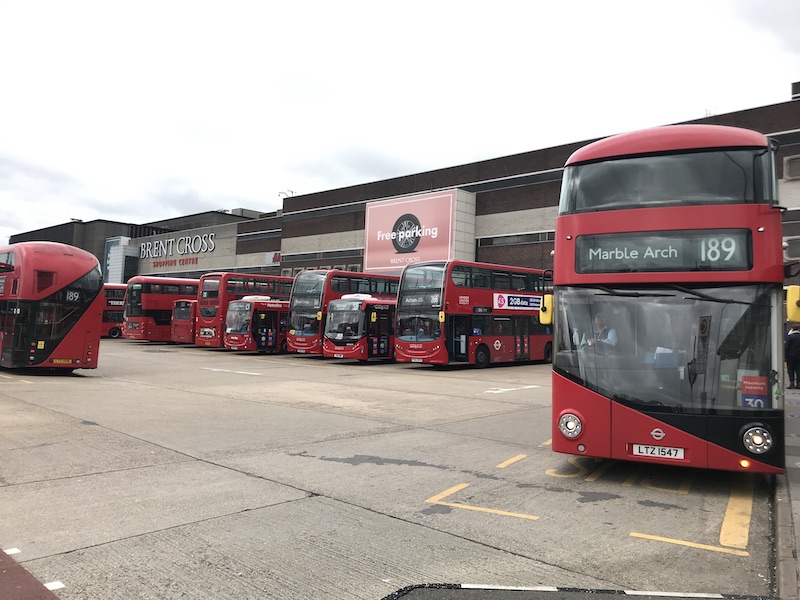
I left the bus at a busy Brent Cross to take a look at how TfL are promoting this new route extension; ok I’m joking; as if TfL would even consider promoting a route extension.

Instead they leave it to a bus enthusiast who manages to secrete a home made information poster into a poster frame and cover up a wildly out of date area bus map … remember those halcyon days?

Suffice to say the information booth was closed, the timetable cases and spider maps gave no indication a 112 now ventured eastwards beyond Brent Cross, but a 112 tile has appeared on the bus stop flag for stop C if your psychic to know that will be towards North Finchley as opposed to Ealing Broadway.

I caught the next 112 towards Ealing which turned out to be a late running and busy bus. We got up to 23 on board despite the Covid maximum of 14 and even then the driver left five passengers behind at one stop who were not happy at all having already had a long wait.

TfL can reassure passengers the route extension won’t increase unreliability because of adequate recovery time at the termini but the problem is the running time isn’t adequate for the regular delays along the North Circular.
We hit more slow moving traffic in Neasden and on the approach to Hanger Lane.
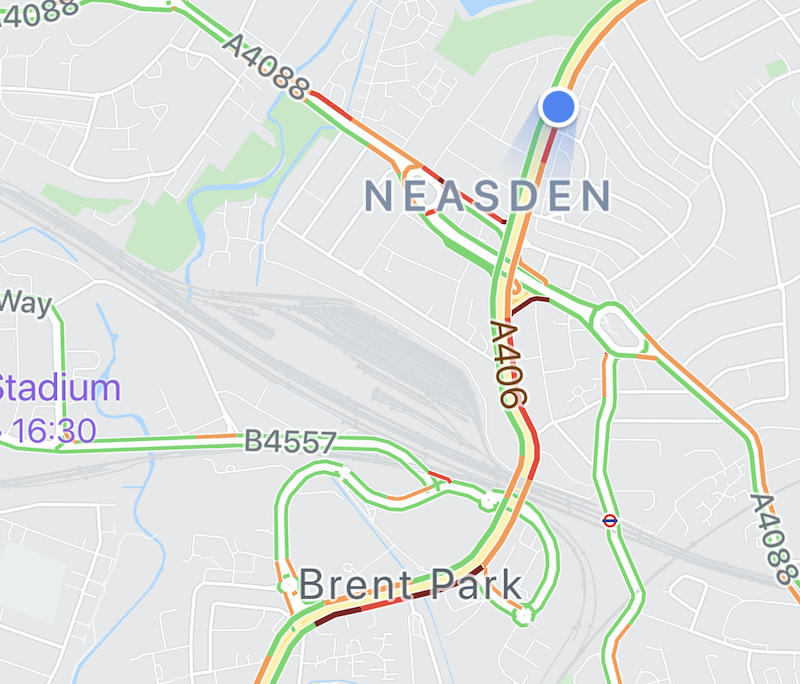
The new diversion via Madeley Road saved a valuable few minutes queuing time at the junction with Uxbridge Road but the new right turn is quite a tricky manoeuvre ….

… as buses share the slightly enlarged space for turning with northbound traffic turning right into Inglis Road opposite Madeley Road.
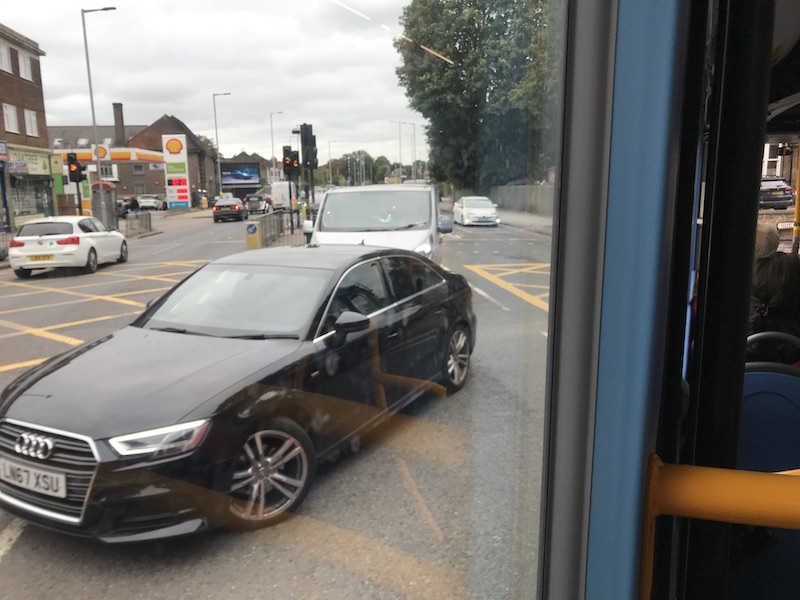
The left hand turn out of Madeley Road is quite tight too.


And it looked like Madeley Road is used as a cut through by locals to get to the North Circular, as it certainly looked quicker than using Uxbridge Road even with a queue at the junction with the North Circular.

The three new bus stops with their build outs….

…..and smart new poles and flags in Madeley Road looked prestine and sported a 112 tile ….

…. but obviously were devoid of timetable information….


…. as was the new departure point – stop D – at Ealing Broadway for passengers wanting to board a 112.

While I was there a mystified passenger went over to a 112 enjoying its stand time round the corner by the Green to enquire of the driver where she should wait. He was very patient in explaining the new arrangements.
I checked out the spider map on stop D where the new 112 departs …

…. and it told me to head to stop F, where it used to depart for Neasden.

But to end the day on a bright spot. I took a look at the timetable case on stop F – where the 112 used to depart up until yesterday and finally found an explanation of the changes being made today.

The only one I saw anywhere for both the new look 112 or 384.
The newly extended 112, with its ten minute frequency and additional 20 minutes running time (27 at peak times) in each direction has meant Metroline have needed to add five more buses on to the 112’s vehicle requirment taking it from 11 to 16. That’s quite a hefty investment for TfL to fund and will take a considerable generation of additional passengers.
All the more so as TfL acknowledge growth on the route is expected in the Brent and Stonebridge Park areas. It does seem odd therefore to add five buses for a new extension eastwards. I’d have thought using that investment to increase the frequency on the former route section would have made more sense rathe than a speculative extension.
Now it’s happened though I would suggest a promotional campaign and some route branding are definitely needed to raise the 112’s profile. Perhaps something along the lines uno introduced on route 383 last year and which I spotted this morning.

Moddest by provincial standards, but at least it’s doing something to raise the profile of where buses go in London. Even more pertinent if they’re being extended like the 112 and 384.
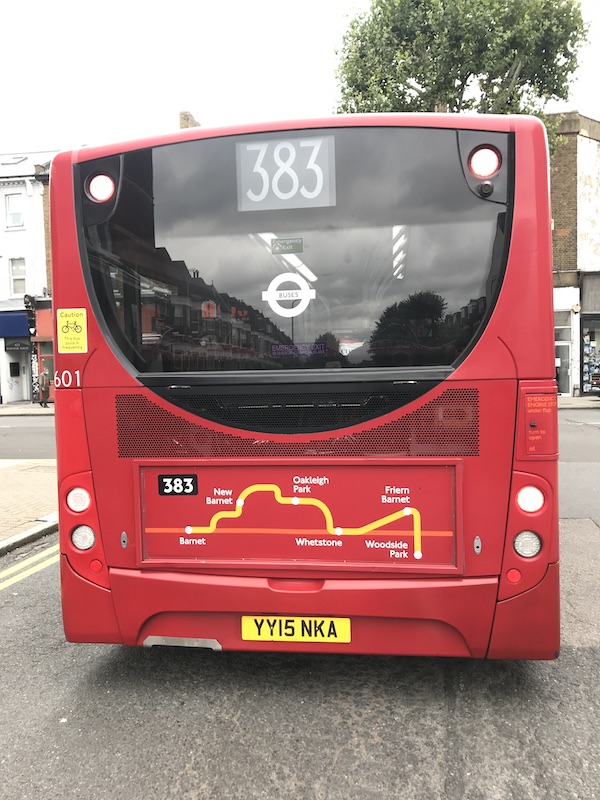
Roger French

TfL: Every Journey Matters (Unless you use Uno)
It’s one of things that I don’t understand about the London permit system. Uno pay good money to access TfL land, you’d think TfL would “promote”/push the Uno service as well. If someone operated a service from Blackburn in to Manchester, I am pretty sure TfGM would mention it. Hey ho, I suppose that’s a quirk of the world class transport system…
LikeLiked by 1 person
Great post again Roger.
The 112 wasn’t cut back in 1970 as I was born in 1981 and remember it still running to Palmers Green. It might have been 1991 or 1992, when the Barnet and Enfield local round of bus changes took effect respectively (I think 384 was also launched in one of these rounds too, not 1990).
I feel sorry for the roads missing out on the 384 but the new route seems like such an obvious proposition, even if a part working of the 614 might have also been a good plan. Maybe the very short 389 or 399 routes in Barnet could be extended to cover bits of the lost 384 route?
LikeLike
How interesting Andrew – I’ve just checked again and in 1978 it was re-extended back to Palmers Green replacing the 212 and continued until 1994 when it was cut back to Brent Cross and the 232 started. I’d forgotten that bit of history – will update the post. Thanks for spotting that.
LikeLike
As you may know Roger whenever in doubt, or not, Ian Armstrong’s site is the place to head to https://www.londonbuses.co.uk/
LikeLiked by 1 person
Interesting article as ever, but always so disappointing to see the lacklustre standards TfL apply to much-needed publicity. Checking Apple and Google maps, neither update their route or live departures information for either of the two routes (the only mention being of route changes on google maps, but only as a status update, the old times are still shown). It is such a shame, as TfL undoubtedly argue that using these can be an alternative to bus stop information (it seems not so). It is therefore a great surprise for TfL to state that as part of new, designated school services on existing bus routes, information “will be posted at relevant bus stops in the biggest bus stop poster campaign in TfL’s history”. If only this much attention were to be paid to bus stops on newly extended routes, where people (bus users even) plausibly are unaware of the much improved service (with the possible exception of some of the residential areas on the 384).
LikeLiked by 1 person
My memory of the 112 goes back to 1966 when it was operated by open-platform RTLs (not fitted with heaters) from Stonebridge Park (SE) and ran between Ealing Broadway and Palmers Green.
LikeLiked by 1 person
Me too; they used to pass my as I walked to school along Bowes Road having got off a 244 in Brownlow Road.
LikeLike
It’s quite disappointing to see the 384 changes get through. The locals around Barnet were actively campaigning to keep it along the roads no longer served. The 384 is back road route as you said, not an orbital trunk route.
There’s a lot of areas in TFL territory that do not have direct links to places at all. Edgware to Barnet already has the 614, and if a passenger does not like Uno, the 107 has done the link perfectly fine for years.
LikeLiked by 1 person
How very typical of the blinkered “we know best” regime of TfL to ignore the excellent UNO 614! In the coming economic climate, such a service should be embraced and integrated with the London network. I suspect we may see a few more withdrawals from outer suburbia where parked cars are many and passengers few. And why no time inter-working with the 292, particularly after a service reduction? As stated many times before, TfL clearly have people who are absolutely wizard at administrative/tender processes, particularly those taking two years to implement (!), but zilch understanding of proper bus service planning. And why oh why does London have this peculiar procedure (and this went on in London Transport days) of worrying about arrival at destination early. Provided the bus has left the last timing point as advertised (except of course times are NOT advertised these days), what the hell does it matter if passengers at least get a decent run on the last leg. We are constantly being told how buses need to be speeded up in the brave new world, yet London buses are now so absurdly slow, certainly on all the routes I have travelled on of late, that passengers are voting with their feet.
LikeLiked by 1 person
The 384 is a North London local route I cannot see much demand to go to Edgware. It might have made more sense to extend it to Wood Green
LikeLike
The extension of Route 384 (and the associated road withdrawals within Barnet) has been contentious for years, but as usual TfL has justified its own decisions and ignored the wishes of existing passengers. Reducing Route 292 to 3 BPH is probably the correct service level throughout the route, although Herts CC weren’t happy about the reduction, but as they don’t pay anything don’t really have any locus to complain!!
I believe that the schedules couldn’t be compiled to provide an even headway without requiring an extra bus in the cycle, which TfL wouldn’t permit (in passing, service specifications and PVR’s are now VERY tightly specified, with the added restriction that all buses MUST be Euro6 from October 2020, and the conversion process is quite expensive, so extra buses are simply verboten now, unless the operator pays the cost).
Concerning running times (and this applies throughout the land), operators are always expecting traffic levels to rise some time soon, thereby reducing speeds achievable. Yes, this is taking time to occur, but when the schools return, and Little Johnny is scared of travelling by bus so Mum’s Taxi will be used, we could see the peak traffic back to pre-C19 levels sooner rather than later!! Schedulers have prioritised restoration of service levels and school duplications recently, but rest assured that running times will be next on the list for attention . . . . if it saves a PVR, then it’ll be worth doing in our Brave New World!!
LikeLiked by 1 person
Presumably TfL ignore Uno routes as they do not accept TfL tickets or passes? The LT Suburban timetable booklets issued until c1970 (?) included LT bus, LCBS bus and coach, NBC and independent bus companies, Underground and even BR services; but that was in the days of cash fares and point-to-point season tickets.
LikeLiked by 1 person
The lack of publicity for these changes is shameful, but not by any means unusual. TfL should be shamed into reintroducing bus maps, which have been systematically withdrawn. When hard copies of the maps were discontinued, these maps continued to be available on-line until comparatively recently, when even this provision ceased.
The spider maps now on offer are inadequate and difficult to use. They do not even begin to replace the former excellent and comprehensive maps which showed the entire course of every bus route and which were readily available to all who wanted them. Their reintroduction would be a win-win situation, enabling people to plan their journeys more effectively and indeed to make more journeys.
Peter Luck
LikeLiked by 1 person